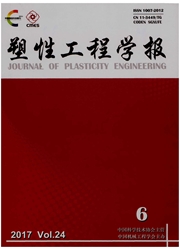

 中文摘要:
中文摘要:
针对内高压成形过程中,对弯曲件质量的严格要求,研究了低碳钢管材的数控弯管过程。采用数值模拟和实验,分析了不同弯曲半径、芯棒和管坯的间隙、芯棒位置和有无防皱块等参数对起皱的影响。结果表明,随着弯曲半径、芯棒直径、芯棒伸出量的增大及采用防皱块的情况下,管材弯曲起皱的趋势减小;在数值模拟的基础上进行了试验研究,试验结果和数值模拟结果吻合较好。采用二倍管径的弯曲半径,芯棒和管材间隙0.015D的情况下,能够有效地避免了弯曲内侧的起皱和外侧的减薄,成形出合格的副车架弯曲件,满足后续的内高压成形。
 英文摘要:
英文摘要:
In order to avoid the defects during tube bending, the computer numerical control (CNC) bending process is investigated. The influence of different bend radius, the clearance between the mandrel and tube, the position of mandrel and with or without wiper die for the wrinkle is discussed by using simulation and experimental method. The simulation and experimental re- sults show that with the increasing of bend radius, the diameter of mandrel, the extending of the mandrel and with the wiper die, the trend of wrinkles is reduced. According to simulation, the experiment is conducted and the result of experiment is agreed well with the simulation result. The wrinkles are avoided and the eligible bend prototype is made which is satisfied the hydroforming of an engine cradle by using 2D bending radius and the clearance between the mandrel and tube of 0. 015D.
 同期刊论文项目
同期刊论文项目
 同项目期刊论文
同项目期刊论文
 Deformation evolution mechanism during hydro-bulging of tailor-welded tube with dissimilar thickness
Deformation evolution mechanism during hydro-bulging of tailor-welded tube with dissimilar thickness An experimental investigation into the formability of hydroforming 5A02 Al-tubes at elevated tempera
An experimental investigation into the formability of hydroforming 5A02 Al-tubes at elevated tempera Effects of loading paths on hydro dynamic deep drawing with independent radial hydraulic pressure of
Effects of loading paths on hydro dynamic deep drawing with independent radial hydraulic pressure of Numerical simulation of flat bottom cylindrical cup by hydrodynamic deep drawing with independent ra
Numerical simulation of flat bottom cylindrical cup by hydrodynamic deep drawing with independent ra PLASTIC DEFORMATION REGULARITY OF TAILOR-WELDED TUBE (TWT) WITH DISSIMILAR THICKNESS DURING HYDRO-BU
PLASTIC DEFORMATION REGULARITY OF TAILOR-WELDED TUBE (TWT) WITH DISSIMILAR THICKNESS DURING HYDRO-BU Deformation and defects in hydroforming of 5A06 aluminum alloy dome with controllable radial pressur
Deformation and defects in hydroforming of 5A06 aluminum alloy dome with controllable radial pressur Research of metal flow during extrusion process under different friction conditions by deforming are
Research of metal flow during extrusion process under different friction conditions by deforming are 期刊信息
期刊信息
